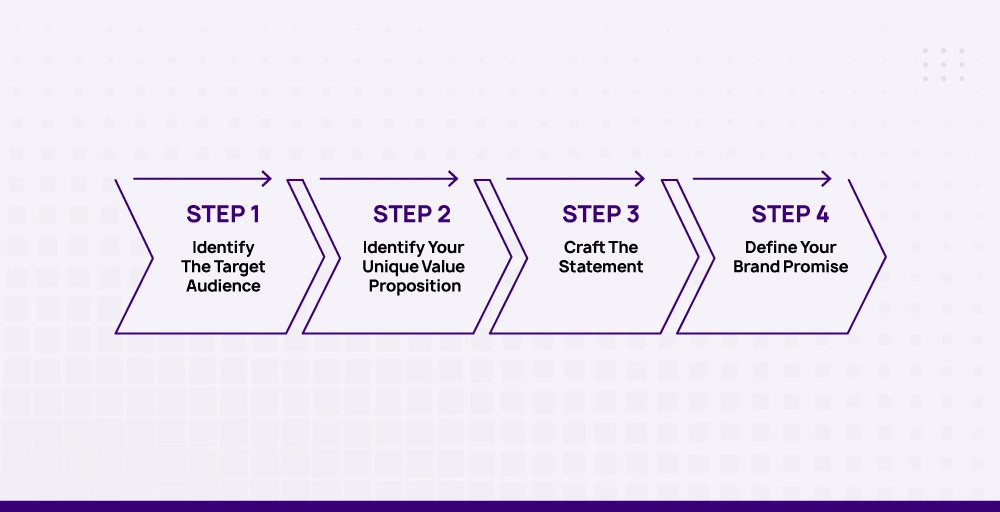In today’s competitive business landscape, a clear and compelling positioning statement is fundamental 😊 for recognizing your brand and connecting with your audience. It communicates who you are, what you offer, and why it matters.
With customers overpowered by choices and experiencing choice weariness, they often struggle to find the best solutions.
Common issues include unclear product benefits, confusion over comparative offerings, and neglected desires. By addressing these pain points, your brand positioning statement can stand out and specifically address customers’ needs.
In this blog, you’ll learn what a positioning statement is with good positioning statement examples, steps to writing your positioning statement, key elements of a positioning statement, and common mistakes to avoid while writing a brand’s positioning statement.
🔑 Key Takeaways
- A positioning statement is a brief explanation of the value and uniqueness of its products or services in its competitive market to set itself apart from competitors.
- One of the successful positioning statement examples is “For individuals looking for a refreshing drink, Coca-Cola offers a unique taste and a sense of happiness and tradition.”
- Before writing a positioning statement first, identify the target market, identify a unique value proposition, craft the statement, and finally define your brand promise.
- The key audience, market category, unique differentiator, and payoff are the 4 key components of a successful positioning statement.
- Don’t be too vague, overload information, or ignore the key audience before crafting a positioning statement.
What is a positioning statement?
A positioning statement is a concise explanation of how a product, service, or brand fits into the market and sets itself apart from competitors. It highlights the brand’s unique benefits and identifies the specific needs of its target audience.

It helps brands stand out from the competition in the congested market by highlighting their advantages and convincing customers to choose them over competitors. By leveraging multiple marketing channels, brands can increase their message and reach a wider range of audience. By continuously delivering on the promised value, a well-written positioning statement not only directs internal decision-making but also fosters brand loyalty.
10 good positioning statement examples
1. Apple Positioning Statement
“For people who need the most excellent individual computer or versatile gadgets, Apple gives high-quality items with cutting-edge design and usefulness which empower clients to form, interface, and work seamlessly.”
Why is this a good brand positioning statement?
- Identifies the target audience by focusing on the individuals seeking the best computer or mobile devices.
- Highlights the market category with its high-quality products.
- Defines brand promise with its cutting-edge design and functionality.
- The reason to believe is due to its reputation for innovation and quality.
2. Coca-Cola Positioning Statement
“For individuals looking for a refreshing drink, Coca-Cola offers a unique taste and a sense of happiness and tradition.”
Why is this a good brand positioning statement?
- Identifies the target audience by appealing to the individuals seeking a refreshing drink.
- Highlights the market category with its unique taste.
- Defines brand promise as a sense of happiness and tradition.
- The reason to believe this is due to its long-standing reputation and iconic status.
3. Amazon Positioning Statement
“For buyers who need to buy a wide extend of items online rapidly, Amazon gives a one-stop online shopping location conveying unmatched comfort and ease of shopping.”
Why is this a good brand positioning statement?
- Identifies the target audience by focusing on the individuals wanting to purchase a wide range of products online.
- Highlights the market category with its unparalleled selection of products.
- Defines brand promise as fast and dependable delivery.
- The reason to believe this is due to its reputation for convenience and efficiency in online retail.
4. Nike Positioning Statement
“For athletes in need of high-quality, fashionable athletic wear, Nike offers innovative products that deliver superior performance and comfort.”
Why is this a good brand positioning statement?
- Identifies target audience by identifying who uses the products and what they need.
- Highlights the market category as high-performance footwear.
- Defines brand promise as innovative products with superior performance and comfort.
- The reason to believe is due to its reputation for quality and innovation.
5. McDonalds Positioning Statement
“For people trying to find a speedy, delightful, and reasonable dinner, McDonalds gives a wide assortment of quality quick nourishment alternatives with inviting benefits over thousands of helpful locations.”
Why is this a good brand positioning statement?
- Identifies target audience by identifying the people seeking fast food.
- Highlights the market category as quick, affordable, and delicious meals.
- Defines brand promise as quality fast food options
- The reason to believe is for its consistent service across convenient locations.
6. Google Positioning Statement
“For people looking for accurate and fast search results, Google provides the most accurate search engine results.”
Why is this a good brand positioning statement?
- Identifies target audience by identifying the people seeking for accurate and fast search results.
- Highlights the market category as the best search engine.
- Defines brand promise as accuracy and speed.
- The reason to believe it is due to its dominance and reputation in the search engine industry.
7. Mural Positioning Statement
“For groups and organizations looking to improve their collaboration and imagination, Mural offers a computerized workspace that encourages visual considering and real-time collaborative planning.”
Why is this a good brand positioning statement?
- Identifies target audience by identifying teams and organizations seeking enhanced collaboration and creativity.
- Highlights the market category as a digital workspace for visual thinking and real-time collaboration.
- Defines brand promise by brainstorming and project planning more effective
- The reason to believe this is, that it provides innovative teamwork.
8. Spotify Positioning Statement
“For music lovers looking for a personalized listening experience, Spotify offers a vast library of songs and innovative discovery tools.”
Why is this a good brand positioning statement?
- Identifies target audience by identifying music lovers seeking a personalized experience.
- Highlights the market category audience as a vast library of songs and innovative discovery tools.
- Defines brand promise as personalized listening.
- The reason to believe it is that it provides an extensive music catalog.
9. Slack Positioning Statement
“For groups and organizations looking to streamline communication and make strides in collaboration, Slack offers an informing stage that coordinates together with your workflow, making group communication faster, more organized, and more productive.”
Why is this a good brand positioning statement?
- Identifies target audience by identifying teams and organizations looking to streamline communication.
- Highlights the market category as a service hub for the messaging platform.
- Defines brand promise by making team communication faster and more organized.
- The reason to believe this is it provides a user-friendly interface and seamless integration with various tools.
10. LinkedIn Positioning Statement
“For experts looking to put through and develop their careers, LinkedIn offers a stage to discover jobs, and share industry insights.”
Why is this a good brand positioning statement?
- Identifies target audience by identifying professionals looking to connect and advance their careers.
- Highlights the market category as a platform for networking, job search, and industry insights.
- Defines brand promise as career advancement opportunities.
- The reason to believe this is for its reputation as a professional networking platform.
How to write a positioning statement?

Writing a positioning statement involves various steps from understanding your brand to offering a unique value. Here’s a step-by-step guide to help you write a good positioning statement:
Step 1: Identify the target audience
Identifying the target market for your product or service is the first step to writing a positioning statement. Recognize their preferences, needs, and pain points. For example, instead of just focusing only on “young adults”, you may also target young professionals in urban areas who value convenience and technology.
As a result, your marketing efforts will be more effective and impactful as you speak directly to individuals who will most likely benefit from and be interested in your products.
Step 2: Identify your unique value proposition
Determining what makes your product or service stand out from the competition and why clients should select you helps you develop your unique value proposition. Your unique value proposition is how you solve particular issues or wants of your key audience better than anyone else.
For example, if you offer a productivity app, your unique value proposition might be “providing a user-friendly interface with customizable features that streamline task management and boost efficiency.
Step 3: Craft the statement
Crafting the statement involves distilling your brand’s essence into a single, attention-grabbing sentence that captures your unique value proposition. The essential elements such as your target demographic, market category, brand promise, and reasons to believe should all be easily integrated into this statement.
For example, if you run a fashion brand, your crafted statement would be “For eco-conscious consumers, GreenWear is the sustainable fashion brand that offers stylish, ethically-made clothing because we use 100% recycled materials and fair-trade practices. This statement explains who you are, what you have to offer, and why clients should choose and trust you.
Step 4: Define your brand promise
Defining your brand promise needs to be a clear, powerful statement that conveys to your target market the special value your brand delivers. It addresses the particular requirements or preferences of your clients offering them strong reasons to select your brand over competitors.
For example, one possible brand promise for an organic skincare brand would something be “to provide high-quality, all-natural skincare products that nourish and protect your skin without any harmful chemicals and side effects.” This highlights the importance of using natural components in skincare products, making them appealing to customers who prioritize health and wellness in their skin care products.
What are the 4 key elements of the positioning statement?
The 4 key elements of the positioning statement are:

- Target audience: It helps to identify the particular customer base that your product or service is meant for. To ensure your message is understood, you must determine the needs, preferences, and demographics of your audience.
- Market category: It describes the sector or industry that your good or service is a part of. Making the market category will assist customers in better understanding what you have to offer by placing your brand inside a defined context.
- Unique differentiator: It helps to make your service or product stand out from the competition. It gives buyers a strong reason to pick you over the competition by meeting a need or resolving an issue that your competitors do not.
- Payoff (benefit): Customers are motivated to choose and stick with your brand only because of the payoff. The reward should show how your solution enhances or resolves the issues that your key audience is facing and directly addresses their requirements or goals.
Common mistakes to avoid
When crafting a positioning statement it is necessary to avoid mistakes, some of which are:
- Being too vague: Your consumers will find it challenging to understand what makes your brand unique if your positioning statement is unclear and lacks details and clarity. Your unique value proposition needs to be successfully communicated and potential customers might not find it appealing.
- Overloading information: If you stuff your positioning statement with too many details, it may confuse readers and weaken the main points. Ensure the most prominent features of your brand and value proposition are highlighted in a brief and targeted manner.
- Ignoring the target audience: When creating a positioning statement, ignoring the target audience can lead to a message that needs to be understood by the people you are trying to reach. Your statement must be customized to meet the specific needs, preferences, and aspirations of your key audience.
Wrapping Up!
Creating a good positioning statement is an investment in your brand’s future. It acts as a directing light for your marketing strategy, ensuring all information resounds with your target market.
A successful positioning statement should be clear, concise, and memorable. It should leave a lasting impression, differentiate from competitors, and ultimately convenience customers to choose.
FAQs
How long should a positioning statement be?
A positioning statement should be clear and concise, typically one or two sentences long.
How do I identify my target audience for a positioning statement?
To identify your target audience, research and understand who your ideal customers are, along with their demographics, preferences, needs, and pain points.
What is the difference between a positioning statement and a value proposition?
The difference between a positioning statement and a value proposition is:
| Positioning Statement | Value Proposition |
| It defines the brand’s unique place in the market. | It explains the benefits and value offered to the customers. |
| It emphasizes market differentiation and brand identity. | It emphasizes the benefits and value provided to customers. |
| Its components are target audiences, market category, differentiator, and brand promise. | Its components are benefits, key features, and the value provided. |
| It is used as a guide for marketing strategy and brand communication. | It is used in marketing materials, sales pitches, and customer interactions. |
What is the difference between a positioning statement and a mission statement?
The difference between a positioning statement and a mission statement is:
| Positioning Statement | Mission Statement |
| It defines the brand’s unique place in the market. | It defines the organization’s core purposes and values. |
| It focuses on market differentiation and brand identity. | It focuses on the organization’s goals, purposes, and guiding principles. |
| Its goal is to establish a unique market position and brand identity. | Its goal is to communicate the overarching purposes and direction of the organization. |





